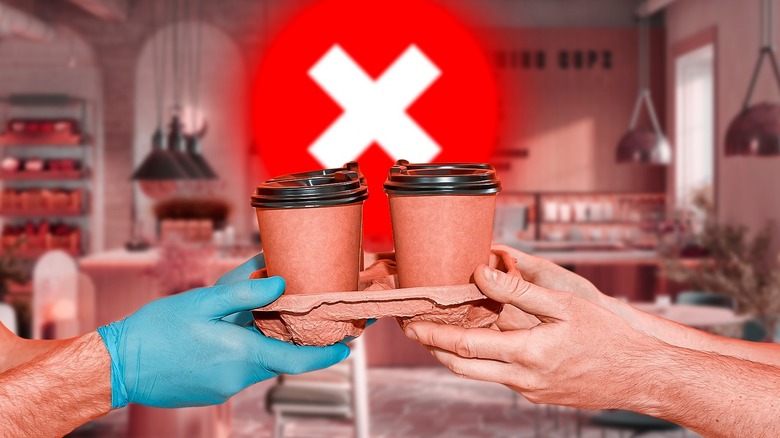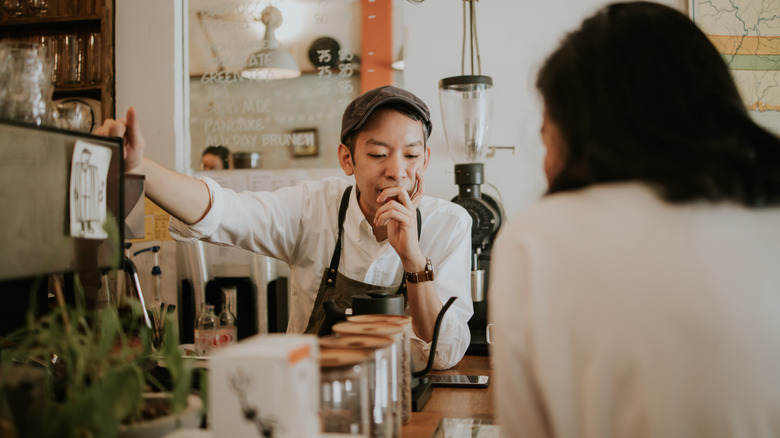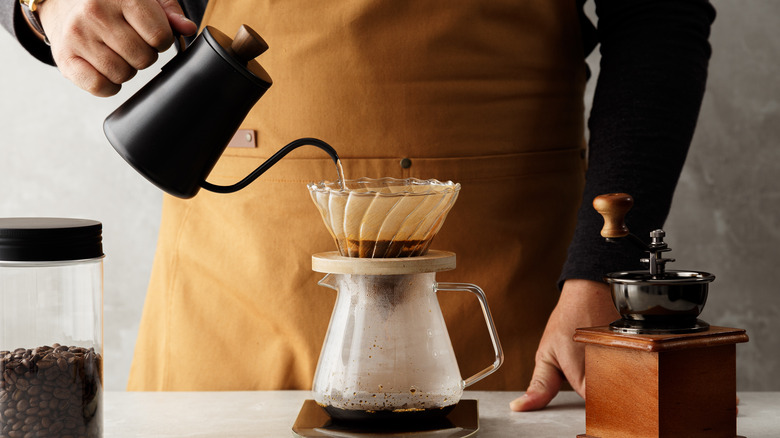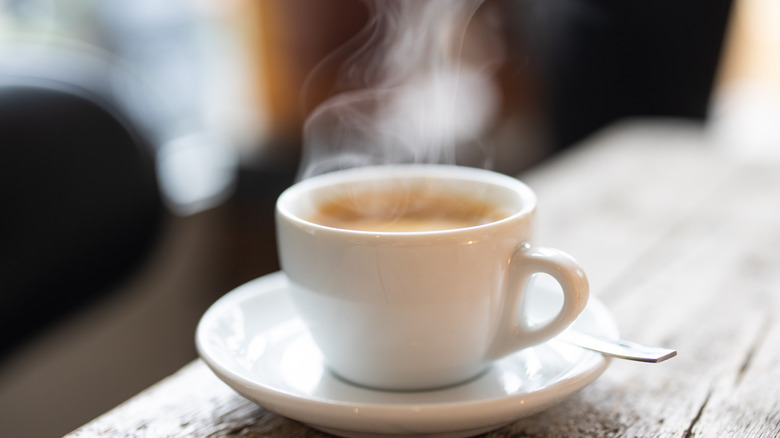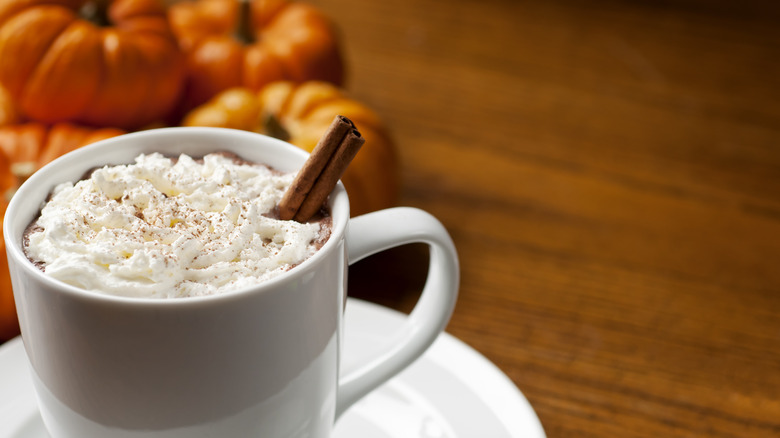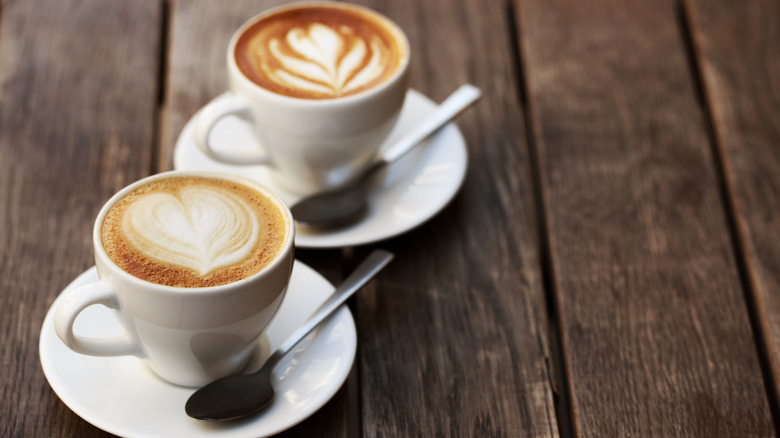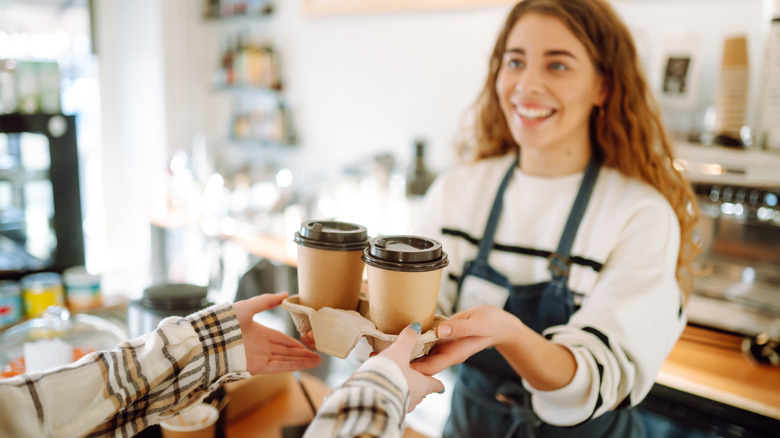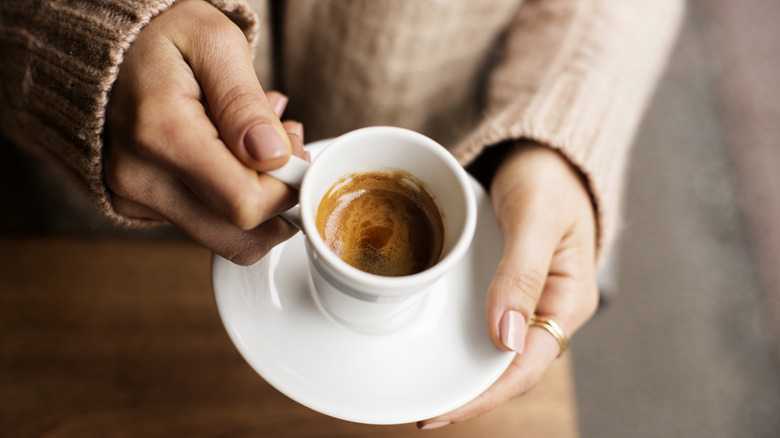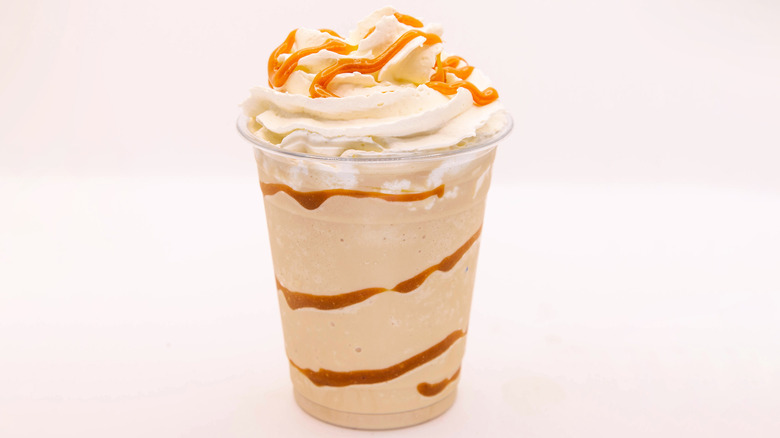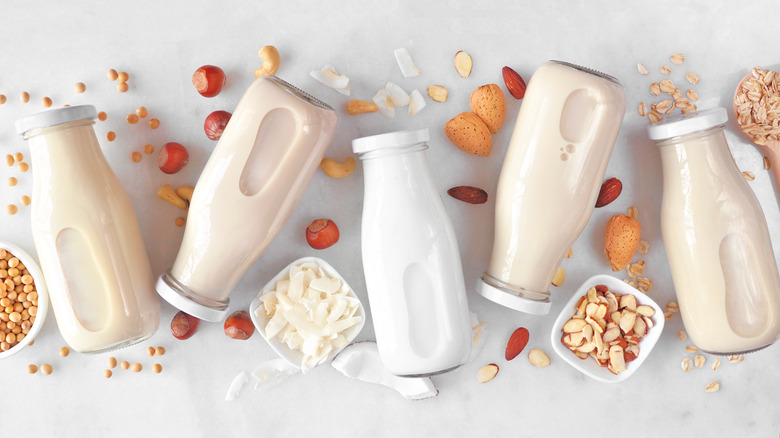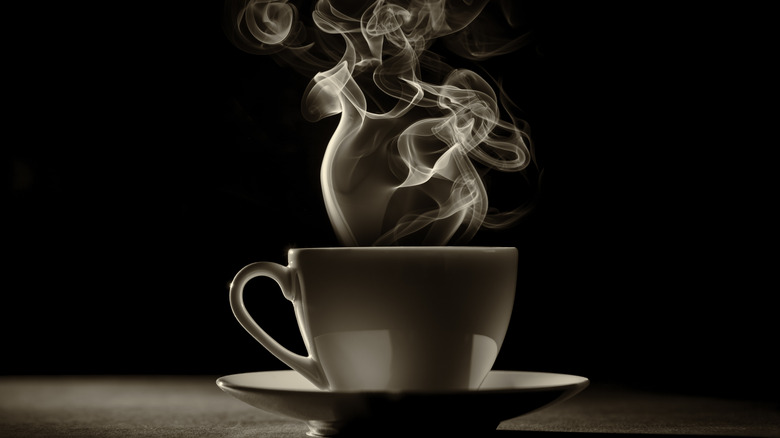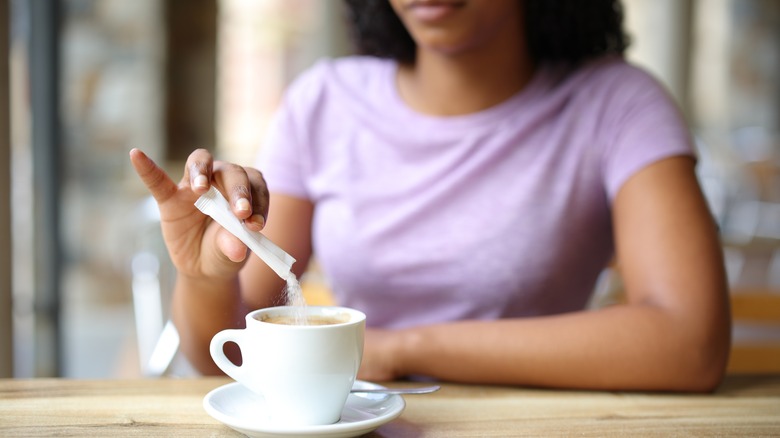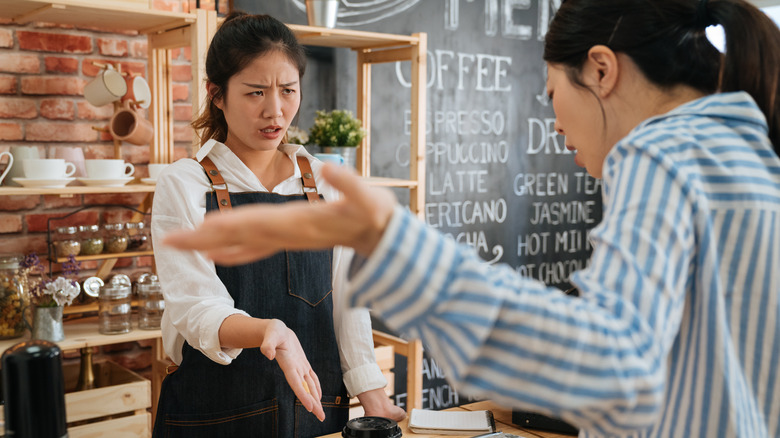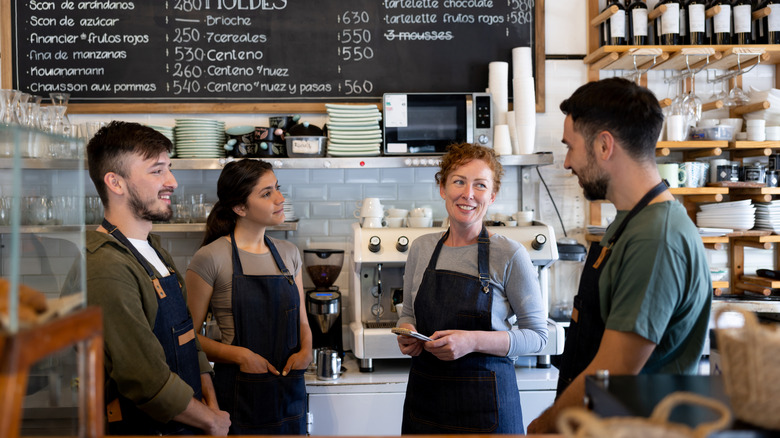14 Mistakes You Should Never Make When Ordering Coffee
There's nothing quite like a piping hot cup of freshly brewed coffee made just the way you like it. And there's a special kind of magic when someone else prepares it for you, giving you the luxury to relax and look forward to the morning boost without having to lift a finger. A coffee shop's warm and welcoming atmosphere surrounds you with a comfortable, almost nostalgic sense of tranquility. It's difficult to resist. In fact, many of us incorporate ordering coffee into our regular routines. Three in four Americans indulge in at least one cup every single day, while about 32% of us grab a coffee to go multiple times a week, per Drive Research. That's a lot of coffee orders filled, which means many of those orders will not come out as the customers envisioned.
For something so deeply intertwined into our culture and daily routine, it's alarming that many of us are doing it all wrong. Your barista doesn't expect every customer to be a coffee expert, but mastering café etiquette and avoiding any red flags ensures you get the drink you've fantasized about all morning, and your barista can feel confident that you'll be satisfied. So, to skirt these shameful slip-ups, we've compiled a list of common coffee conundrums to help you identify why your joe is falling flat.
Getting too specific with your coffee order
For those of us who are self-proclaimed coffee connoisseurs, a steamy cup made exactly how we prefer it is one of the greatest joys in life. While we all know what we like and want everything made to fit our specific requirements, the truth is that when someone else is preparing something for you, it's not wise to be too particular. Asking for too many additions, substitutions, and specific quantities of ingredients can easily render your barista stumped, and you'll wind up with the completely wrong order.
Instead, familiarize yourself with the coffee menu at your favorite café and choose a beverage that closely aligns with your preferences. Making minor additions or substitutions is acceptable. If you must order off-menu, bear in mind that there are numerous customers placing orders before and after you, each with distinct requests that your barista must fulfill accurately. By keeping your order straightforward, your coffee is more likely to be delicious rather than a mishmash of obscure flavors, inconsistent ratios, and unappealing ingredients.
Adding a ton of cream and sugar to a pour-over
Pour-over is arguably one of the best coffee-brewing methods for producing a balanced, bright, and flavorful cup. If you find yourself lucky enough to be in a café specializing in this popular brewing technique, it would be absurd not to indulge. Preparing pour-over coffee requires time, effort, and skill. So, if you go for it, know that there are some pour-over faux pas that, if committed, could ruin your delicately prepared beverage.
Taking the time to make this trendy coffee may seem like a lot of effort, but it's certainly worth the endeavor. It would be a shame to convolute all of that effort that your barista put into making a perfect pour-over by masking the unparalleled taste with loads of milk, sweetener, or flavor syrups. This tried-and-true brew is known for conjuring up a rich taste with intense aromas and a palatable texture that would all be for nothing if masked by tons of additions. So, if you prefer your coffee extra light and sweet, stick to a standard drip coffee and save your barista the trouble.
Putting espresso where it doesn't belong
The thought of transforming your favorite non-caffeinated beverage into a drink that gets you geared up and ready to take on the day is tantalizing. But there's a reason why this isn't always recommended. Espresso is bitter by nature, so it doesn't blend well with everything. Adding it to other bitter drinks can leave you with an unpleasant-tasting beverage. For example, dirtying up your matcha with coffee may seem like a fantastic idea, but the bitterness of both these drinks will hit you like a hostile ton of bricks. However, if you ensure that the matcha at your favorite coffee shop is served sweetened, or you add sweetener yourself, then espresso and matcha could be a match made in heaven.
Conversely, two bitter flavors merge seamlessly in a delightful combination of espresso and tonic water. You would think that these tastes would contrast, but they come together to form a refreshing treat, infusing a citrusy undertone that will energize you for the day ahead. This drink is creamy with a bright and crisp flavor, perfect for summertime, making it a trendy new substitute for iced coffee. So, if you're not sure if a drink will pair well with the addition of coffee, it's a good idea to ask your barista for advice before you get a little too creative with your café concoctions.
Expecting seasonal drinks to stick around
We all have our cherished seasonal drink to look forward to at a specific time of year. However, a common dilemma is that we get too attached and expect that drink to be accessible year-round. It's not uncommon for a café to prolong the availability of a popular drink after the season has ended. But don't allow the coffee shop's graciousness to leave you too attached, expecting that extension to last all year.
Every barista has to deal with customers asking for a lavender cappuccino outside of springtime or a gingerbread latté in the summer. Instead, ask your barista for a recommendation, expanding on your preferences and favorite drinks so you can get something similar to your ideal choice. Or, if you really want to go the extra mile and get your sweet, seasonal satisfaction, you can make your favorite drink at home. Whip up the most iconic, autumnal drink of all — the pumpkin spiced latte – from the comfort of your kitchen with our DIY PSL recipe, and you'll never need to rely on timely trends again.
Confusing a cappuccino and a latté
Espresso beverages are usually distinguished by their own unique names, and memorizing them requires time and patience. The most crucial thing to understand is the definitions of the two most common espresso-based beverages: lattés and cappuccinos.
The same ingredients go into making both lattés and cappuccinos — espresso and frothy milk — but there is one stark difference between the two: their milk-to-espresso ratios. Cappuccinos come with equal parts milk, espresso, and foam. Considering their higher foam quantity, they tend to be frothier, less milky, and less often served pre-sweetened. The flavor of the espresso shines through more so in a cappuccino than in a latté. It's common to see this drink doused with a generous amount of cinnamon or spice blend, delicately coating the rounded mountains of foam that top the cup.
Lattés, on the other hand, are made using one part espresso and two parts milk with a dollop of foam gracing the top of the beverage. They're more likely to come with the addition of a flavored syrup or to be transformed into a sweet, seasonal delight. Since they're much milkier than a cappuccino, the flavor of the espresso is masked, creating a creamy, sippable delicacy.
Not trusting your barista
The reality is that not everyone entering a café is a coffee expert. However, you can be confident that your barista is well-versed in coffee. Therefore, it is crucial to heed their recommendations and pay attention to any advice they offer. Even if you consider yourself a coffee connoisseur, the local roaster's barista has in-depth knowledge of the cafés coffee offerings. Taking their suggestions ensures that you leave content with your choice while they're satisfied with the service they render.
It's a barista's job to ensure that the coffee's integrity stays intact, which may lead to the refusal of certain requests. If you ask them to put your espresso in the microwave, for instance, they'll likely turn you down, knowing that you won't be satisfied with the offputting result. Similarly, if you ask for a hot beverage to be poured over ice, you are likely to face a refusal. Pouring hot drinks over ice waters them down significantly and ruins the quality of the drink, a fact that many baristas wish their customers knew. If your coffee doesn't meet your expectations, you can always ask them to make one that aligns with your preferences (within reason), and they'll be happy to accommodate you.
Only sticking to what you know
One of the biggest blunders you can make as a regular coffee consumer comes from getting too comfortable. You probably have a go-to drink if you order coffee daily. It can be hard to stray from your tried-and-true, but in doing so, you'll unlock a plethora of other coffee offerings, perhaps even your new must-have beverage.
Take some time to explore your local café's coffee menu. Most coffee shops try to have a couple of drinks that are unique to the establishment on top of the essentials. A café's specialty drinks are usually the most delicious, so give those a try first. Even if a drink seems like something you wouldn't like, it never hurts to explore new territory. Make sure to let your barista know that you're branching out and trying the drink for the first time. They'll likely make it with extra care to help you discover your new potential favorite.
Ordering a caramel macchiato outside of Starbucks
If you're a regular Starbucks enthusiast, you're probably familiar with the famed caramel macchiato. This delectable drink comes iced or hot, is loaded with vanilla syrup, and generously drizzled with caramel. Although this drink is a fan favorite, it comes with a misleading name. You might have tried to order the Starbucks staple at a small coffee shop and received the side-eye from the barista and wondered why. Considering its unfortunate dual nature, this drink order is a red flag for baristas.
A macchiato — sometimes called a traditional macchiato on café menus thanks to Starbucks — is made with espresso, a dollop of milk foam, and nothing more. So that sweet treat you indulge in weekly has more in common with a latté than a genuine macchiato. Since the traditional version of the drink has no milk, it's intended to be espresso-forward. Adding caramel would be unnecessary and ruin the flavor of the espresso. If you want a Starbucks macchiato from a non-chain coffee shop, try ordering a vanilla latté with whipped cream and caramel drizzle on top. Or, you can ask the barista to craft the Starbucks adaptation of the drink. Their experience with this particular mix-up likely means they'll be able to provide you with the sugary caffeine fix that you're after.
Expecting a drink to be sweet
Oftentimes, artisanal coffee drinks come pre-sweetened, usually with flavor syrups. You can generally expect a café's signature beverage to come sugar-laden, but it's not always the case. If a drink is something along the lines of an apple pie latté or a cookie dough café au lait, then it's probably safe to assume that it's sweetened already. However, standard lattés or cappuccinos at reputable establishments never have sugar added by default unless you explicitly request it.
If you like your drinks to be at a particular sweetness level, always ask your barista whether or not the drink can be made according to your preference. Usually, to impact the sugar levels requires only using more or less flavor syrup. However, this may mean compromising on flavor if you prefer a less sweet taste. Check if the café offers beverages flavored with unsweetened syrups or spices, allowing you to alter your drink to your liking while preserving the intended flavor.
Not specifying what milk you want
Chances are you enjoy your coffee drinks prepared with a certain type of milk. Nowadays, there are a plethora of milk options to choose from, so it's necessary to be specific. Most coffee shops offer a variety, from classic dairy to plant-based staples like almonds and oats, with some offering unique plant-based milk choices, such as hemp or flax. If you don't specify and your barista doesn't ask, you'll wind up with the café's standard — usually whole milk or 2% milk, depending on the region.
Sometimes, your favorite milk isn't always best for the specific drink that you order. If you want a foamy, eat-it-with-a-spoon-style coffee, you should choose the best milk for a cappuccino – milk that froths well. For pillowy soft layers of rich cappuccino foam, choose high-fat milk. Whole milk is perfect for getting those quintessential, indulgent mounds atop your steamy beverage. If you'd rather go the non-dairy route, try extra-creamy oat milk if your local coffee roaster offers it, or whichever plant-based milk substitute has the highest fat content.
Asking for an extra hot drink
There's nothing more disappointing than taking that first much-anticipated sip of your specialty coffee, prepared just for you, and discovering that it's only lukewarm, at best. A hot, caffeinated drink on a cool, crisp day is the perfect wake-up, and to compromise that is a sin of the highest order. While receiving a tepid beverage is unacceptable, crafting an excessively hot one is almost impossible without compromising the milk's integrity. So if you're the type that enjoys a scalding drink, we regret to inform you that you might need to prioritize taste over temperature and sacrifice that preference.
Overheating milk is one of the most common ways to ruin a coffee drink. When milk is heated to a temperature over 160 F, the proteins denature, and it becomes acrid and sour, making your beverage undrinkable. Asking your barista to make your drink extra hot could easily result in this coffee catastrophe, turning the most enjoyable aspect of your morning routine ugly.
Adding sugar to flavored drinks
Infusing a drink with flavors is the most fun way to jazz it up and create a customized drink tailored to your preferences. However, when incorporating flavors or selecting a pre-flavored option from a coffee menu, it's important to note that these add-ons are probably derived from syrups that are almost entirely sugar.
The quantity of syrup you add to your drink directly influences the intensity of its specific taste and its overall sweetness. While it's obvious that additions like chocolate and caramel impart a sugary boost, seemingly non-sweet options like lavender, hazelnut, and mint are usually based on sugar-infused syrups as well. Even sugar-free alternatives generally use artificial sweeteners.
Unless you like a sugary drink that puts liquified candy to shame, remember that adding sugar to a flavored beverage will result in a sugar overload. Sweetening drinks to your preferred taste is easier without flavor syrups. Inquire with your barista about any available flavored coffees; these typically rely on natural spices and plant essences for their taste, avoiding the need for added sugar.
Being rude to your barista
One of the most prominent faux pas that your barista wishes they could put a stop to is the neglect of basic niceties. Look — we get it. It's early in the day, and you're still awaiting that caffeine buzz to slap a smile on your face and help you power through the humdrum of the morning. It might take a little extra effort to be polite so early in the day, but we can assure you that your consideration will be much appreciated.
If you enter a coffee shop with a gracious smile for your barista, remember your "please" and "thank you," and let them know how much you appreciate them, their shift will go much more smoothly. Taking the time to go the extra mile courteousness-wise might even work out in your favor. It's not uncommon for a barista to give a pleasant customer a little surplus of whip on their mocha or to craft their beverage with extra care. On the contrary, if you're particularly rude to the person taking the time and effort to prepare your morning pick-me-up, don't be surprised if you don't feel as lifted as usual. Rude customers receiving decaf in their drink is a fair and just punishment for an unpleasant attitude.
Choosing chain coffee over a local roaster
There's nothing wrong with a little Starbucks or Dunkin' from time to time. The ease and convenience of chain coffee shops are usually worth it when you're in a rush or looking for a drink with no frills or surprises. But if you want to truly delve into the world of coffee, nothing beats a drink from the best local coffee roaster in your area. A quality cup of organic joe served simply black is an exceptional treat, and it tastes even better knowing that you're helping your local economy grow. If you're fortunate enough to live near an esteemed coffee shop that serves a fresh, locally roasted brew, it would be a crime not to indulge.
Not only does the coffee taste better at a small coffee shop, but you also receive better customer service. Usually, the customers at small cafés are made up of mostly regulars, and it's no secret that regulars get the best service. Once you find a favorite local coffee house, start ordering there instead of your usual chain of choice. Attaining regular status at a café marks one of the most significant triumphs in the coffee realm.
